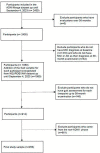Predictive power of gait and gait-related cognitive measures in amnestic mild cognitive impairment: a machine learning analysis
- PMID: 38348371
- PMCID: PMC10859484
- DOI: 10.3389/fnhum.2023.1328713
Predictive power of gait and gait-related cognitive measures in amnestic mild cognitive impairment: a machine learning analysis
Abstract
Introduction: Gait disorders and gait-related cognitive tests were recently linked to future Alzheimer's Disease (AD) dementia diagnosis in amnestic Mild Cognitive Impairment (aMCI). This study aimed to evaluate the predictive power of gait disorders and gait-related neuropsychological performances for future AD diagnosis in aMCI through machine learning (ML).
Methods: A sample of 253 aMCI (stable, converter) individuals were included. We explored the predictive accuracy of four predictors (gait profile plus MMSE, DSST, and TMT-B) previously identified as critical for the conversion from aMCI to AD within a 36-month follow-up. Supervised ML algorithms (Support Vector Machine [SVM], Logistic Regression, and k-Nearest Neighbors) were trained on 70% of the dataset, and feature importance was evaluated for the best algorithm.
Results: The SVM algorithm achieved the best performance. The optimized training set performance achieved an accuracy of 0.67 (sensitivity = 0.72; specificity = 0.60), improving to 0.70 on the test set (sensitivity = 0.79; specificity = 0.52). Feature importance revealed MMSE as the most important predictor in both training and testing, while gait type was important in the testing phase.
Discussion: We created a predictive ML model that is capable of identifying aMCI at high risk of AD dementia within 36 months. Our ML model could be used to quickly identify individuals at higher risk of AD, facilitating secondary prevention (e.g., cognitive and/or physical training), and serving as screening for more expansive and invasive tests. Lastly, our results point toward theoretically and practically sound evidence of mind and body interaction in AD.
Keywords: Alzheimer’s disease; amnestic mild cognitive impairment; artificial intelligence; cognitive dysfunction; gait abnormalities; motor system.
Copyright © 2024 Tuena, Pupillo, Stramba-Badiale, Stramba-Badiale and Riva.
Conflict of interest statement
The authors declare that the research was conducted in the absence of any commercial or financial relationships that could be construed as a potential conflict of interest.
Figures




References
-
- Ahn S., Chung J. W., Crouter S. E., Lee J. A., Lee C. E., Anderson J. G. (2023). Gait and/or balance disturbances associated with Alzheimer’s dementia among older adults with amnestic mild cognitive impairment: A longitudinal observational study. J. Adv. Nurs. 79 4815–4827. 10.1111/jan.15768 - DOI - PMC - PubMed
-
- Bucholc M., Titarenko S., Ding X., Canavan C., Chen T. (2023). A hybrid machine learning approach for prediction of conversion from mild cognitive impairment to dementia. Expert Syst. Applic. 217:119541. 10.1016/J.ESWA.2023.119541 - DOI
Grants and funding
LinkOut - more resources
Full Text Sources

